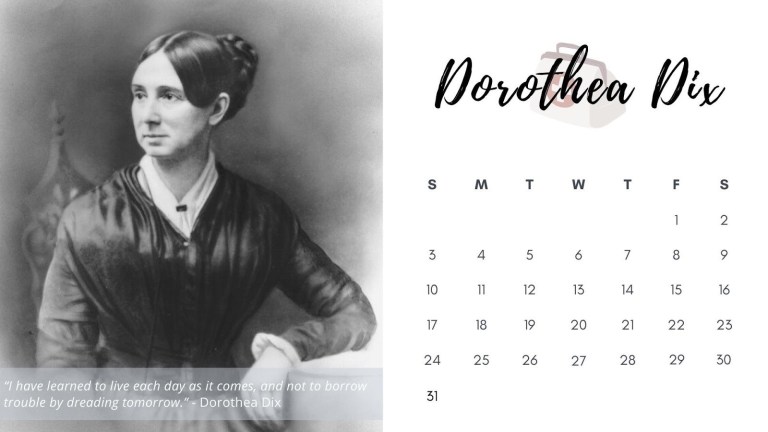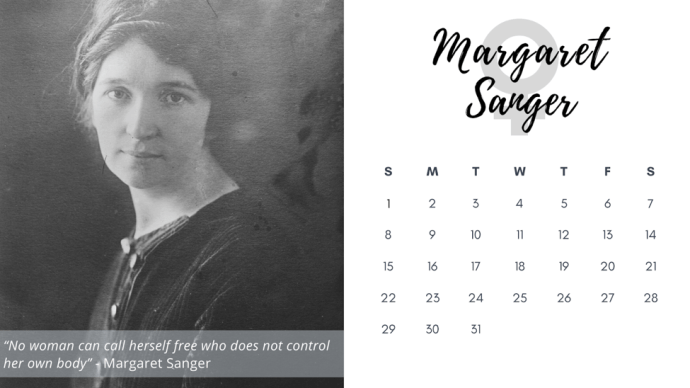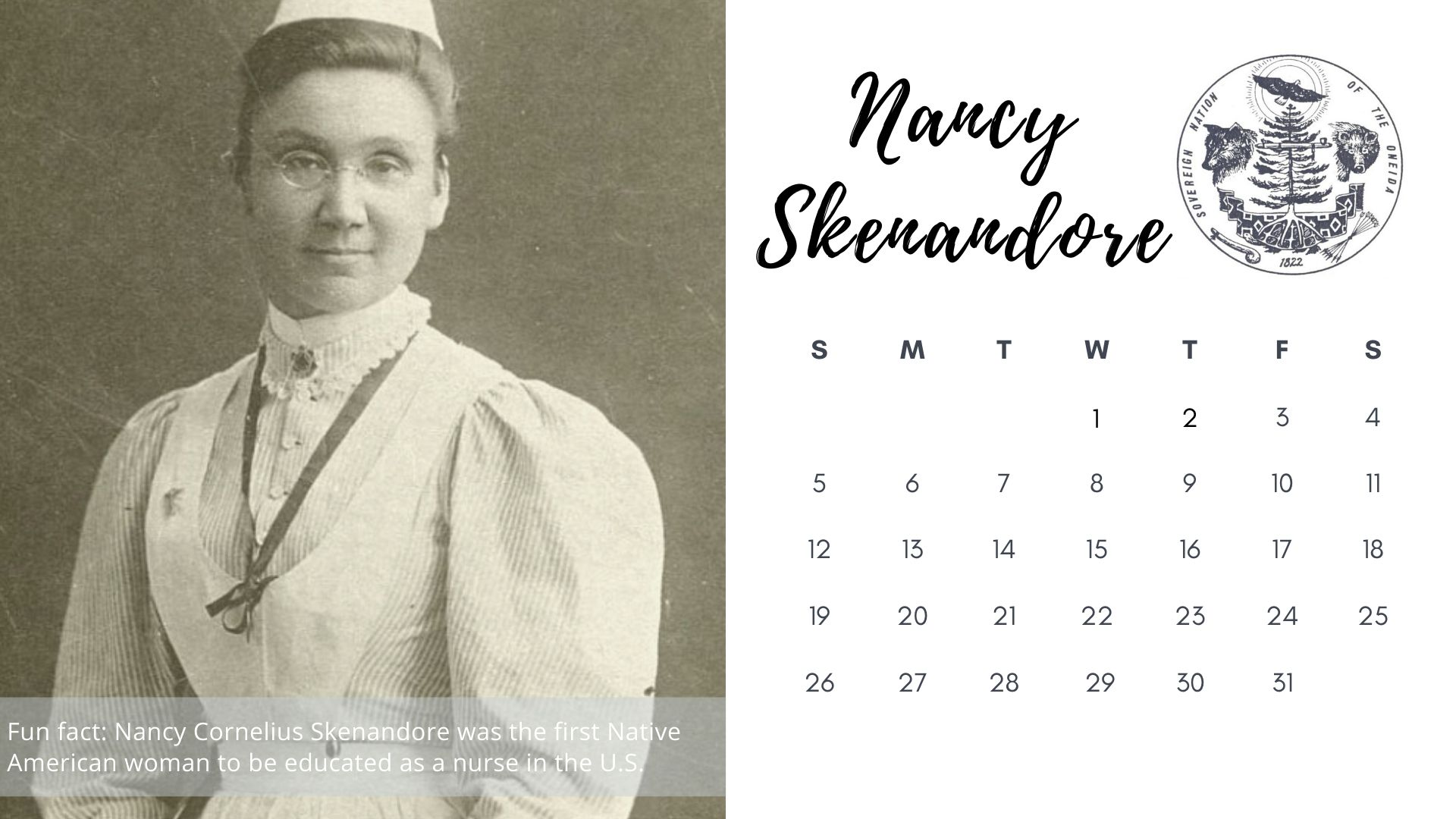Year of the Nurse2020 - Year of the NurseThe World Health Organization (WHO) has designated 2020 as the “Year of the Nurse and Midwife”, in honour of the 200th birth anniversary of Florence Nightingale. The year 2020 is significant for WHO in the context of nursing and midwifery strengthening for Universal Health Coverage. WHO is leading the development of the first-ever State of the World’s Nursing report which will be launched in 2020, prior to the 73rd World Health Assembly. For more information, visit the World Health Organization website. December
During the second wave of the Covid-19 pandemic, this December we would like to honor Nurse Lillian Wald. Born into a wealthy family, Lillian Wald had no idea of the poverty and hardships that those who were underprivileged experienced. Her first encounter was when she attended the New York Hospital School of Nursing. This was the beginning of her tireless work which took place during the American Progressive Era from 1890 to 1920. Her first humanitarian act, one having the greatest impact in history, was the establishment of the Henry Street Settlement in 1893 after her exposure to the challenges faced by immigrants on the Lower East Side of New York. Her primary goal was to create an environment where nursing services could be provided to those less fortunate. Lillian Wald was a fierce advocate, lobbying for parks for children, development of decent housing for all, as well as fighting for the rights of immigrants, women and children. It was evident by her active participation in reforms lobbying to the establishment and evolution of organizations such as the National Association for the Advanced Placement of Colored People, National Child Labor Committee, United States Children's Bureau, and the National Women's Trade Union League. It would be a shame to not mention her strong passion and dedication to public health nursing as she is one of the pioneers that achieved this by placing nurses in public schools. Our hearts go out to all the health care workers working tirelessly in the overwhelmed public health sector over the Covid-19 pandemic. We wish America and the world a speedy recovery through the festive seasons. References: Filiaci, A. M. (2020). Menu. Lillian Wald Public Health Progressive. November
This November, we are honoring nurse Clara Barton who was a teacher, women's rights activists, nurse and founder of the American Red Cross. Barton was in Oxford, Massachusetts on December 25, 1821 as the youngest of five children. As a young women, she worked as a teacher and at age 24, she founded a school for the local millworker's children. Seven years later, in 1852 she founded a second school in Bordentown, New Jersey. After learning that a male teacher was earning twice her income, she resigned and said that she would never work for less than a man. This led Barton to Washington DC where she was hired as the first women recording clerk at the US Patent Office, a position that paid her the same salary as her male colleagues. In 1861, the Civil War began and Barton felt a strong desire to help the Union soldiers. She quit her job and started to deliver supplies to soldiers on the frontlines, even in the middle of battles. Seeing the need for medical attention, Barton became a nurse and provided care and comfort to the wounded and dying soldiers, despite having no formal nursing training. Her bravery and service earned her the nickname "Angel of the Battlefield" and in 1864, she was appointed as the Superintendent of Nurses for the Army of James. After the war, her work continued as she helped locate missing soldiers, marked graves, and testified at Congress about her wartime experiences. In 1869, to recuperate from burnout, Barton traveled to Switzerland where she learned about the International Red Cross. When she returned home, she began to campaign through pamphlets, lectures, and even meeting with President Rutherford B. Hayes to bring the Red Cross to America. In 1881, the American Association of the Red Cross was formed, and Barton was elected president. Although Barton passed away in 1912, the American Red Cross continues to carry her legacy and her spirit of service through their invaluable work of disaster preparedness and response, blood services, and community training. Sources: https://www.womenshistory.org/education-resources/biographies/clara-barton https://www.redcross.org/about-us/who-we-are/history/clara-barton.html October
This October, we will be honoring Mary Breckinridge, a pioneer in midwifery in America. Mary Breckinridge was born in 1881 in Kentucky. As a young woman, she became widowed at 26 and lost both of her children when they were young. Afterwards, "Breckinridge dedicated her life to improving the health of woman and children". She became a registered nurse in New York at St. Luke's Hospital in 1910. Later she served in France in World War I and was inspired by the British midwifery she saw during trips to London. After her return, she studied public health nursing at Columbia University and was dedicated to educating rural communities about prenatal care and safe birthing practices. Breckinridge became a certified nurse midwife in London and studied midwifery in Scotland. She brought that knowledge back to Kentucky and began the Frontier Nursing Service (FNS) in 1925. The FNS focused on providing low cost prenatal and childbirth care to underserved communities. The program decreased maternal and infant mortality rates immensely in the area, with only 11 maternal deaths in 17,053 births. The creation of the FNS led to the start of the American College of Nurse-Midwives, the American Association of Nurse-Midwives, and the FNS School of Midwifery and Family Nursing. Mary Breckinridge passed away in 1965, but left behind a legacy of the "longest continually operating nurse-midwifery program in the country". References: https://www.truthaboutnursing.org/press/pioneers/breckinridge.html#gsc.tab=0 September
For the month of September, we would like to honor and recognize Bonnie Bullough. Bullough was known for her contributions to the nurse practitioner movement in California and was an author of over 30 books on topics regarding healthcare, nursing, and sexuality. Born in 1927 in Utah, Bullough graduated as a class valedictorian and joined a cadet nurse program after high school. Her interest in nursing was sparked by her own hospital visits throughout her youth. Bullough went on to marry her high school sweetheart and after a brief stay in California, they moved to Chicago, where Bullough worked as a scrub nurse for the University of Chicago and later as a public health nurse for the Chicago Public Health Department. In 1959, Bullough and her family relocated to Los Angeles and she received her master’s in nursing and a Ph.D. in sociology from UCLA. In 1968, as a faculty member of UCLA, she created the first nurse practitioner program in California. Bullough went on to become a coordinator of graduate studies at CSU Long Beach and head of a consortium of colleges and universities whose goal was to expand nurse practitioner education. In 1979, she became dean of nursing at Buffalo State in New York. Although Bullough fell ill shortly after becoming dean of nursing, she continued until 1989. In 1993, she went back to Los Angeles and helped restructure the department of nursing at USC. Before her untimely death in 1996, Bullough assisted with the development of a nursing doctoral program at USC. References: Bullough, V. L., & Sentz, L. (Eds.). (2004). American nursing: A biographical dictionary. Volume 3. Springer Publishing Company. August For the month of August, we would like to highlight Mabel Keaton Staupers. Mabel immigrated to the United States from Barbados at age thirteen. In 1917 she graduated from Freedmen's Hospital School of Nursing in Washington D.C., and began her career. She devoted much of her time to caring for her community and their health disparities. Mabel played a key role in organizing one of the first inpatient clinics in New York that allowed Black physicians to treat patients. She was also involved with the National Association of Colored Graduate Nurses where she took a stand against the discriminatory policies that the United States Army held against the Black nurse community. During that time, only 56 Black nurses were allowed to join the service, however, they had to follow the segregation practices. Mabel advocated for the nurses and even sat with the First Lady, Eleanor Roosevelt, to explain the situation. In January 1945, the United States Army began to accept all nursing applicants regardless of their race. In 1951, she was awarded the Springarn Medal by the National Association of Advancement of Colored People. Mabel passed away in 1989 at the age of 99. Sources: https://www.blackpast.org/african-american-history/staupers-mabel-keaton-1890-1989/ July
For the month of July, we would like to honor and recognize Nancy Cornelius Skenandore, the first Native American to train as a nurse. Skenandore was born in 1861 on a reservation southwest of Green Bay, Wisconsin. She was a member of the Oneida tribe, which had been moved by force from New York in 1823. Skenandore attended an American Indian school in Carlisle, Pennsylvania, which was an off-reservation boarding school. She then studied nursing at Hartford Training School for Nurses and graduated in 1890. Eventually, Skenandore returned to Wisconsin to work at Oneida Mission Hospital, where she worked as superintendent until 1905. The hospital did not have a resident physician, so Skenandore took on a great deal of responsibility in caring for her patients. In 1901, Skenandore married and left formal nursing, but continued to practice until she passed away from cancer in 1908. Skenandore is buried in Hobart Oneida Cemetery. It is important for us to learn about the history of Nancy Skenandore because she was one of the first Native Americans to enter the nursing profession and opened the door for so many others. Other notable Native American nurses include Susie Yellowtail, Elizabeth Sadoques Mason and Maude Sadoques. Unfortunately, despite recruitment efforts, not many Native Americans have followed in their footsteps, and Native Americans are the most underrepresented minority in the nursing profession. Sources: https://www.workingnurse.com/articles/Nancy-Skenandore-Native-American-Role-Model https://en.wikipedia.org/wiki/Nancy_Cornelius June For Pride Month we would like to recognize Cliff Morrison for his work during the AIDS epidemic. Cliff Morrison began working a custodial job in a Florida hospital at the age of 12. With encouragement from his coworker, he entered an Associates degree in nursing program at the age of 17, he was the youngest student ever accepted into nursing school and the first person in his family to attend college. Initially, Cliff's goal was to use his earnings to attend medical school because at the time it was expected that men become physicians rather than nurses. However, Cliff came to love the profession of nursing and went on to complete his bachelor's degree as well as additional degrees in Public Health and Business Administration. By 1979, Cliff was teaching in an undergraduate nursing program and working towards Master's degrees in Nursing and Adult Education. It was at this time that he marched in Miami's Pride parade; outing himself as a gay man. The resulting backlash caused Cliff to decide to move to San Francisco where he would begin working as a psychiatric nurse at San Francisco General Hospital at the start of the AIDS epidemic. After seeing the stigmatization that AIDS patients were subjected to, he established 5B/5A which was the first ever ward dedicated to the care of AIDS patients. The coordinated care model became known as the San Francisco Model and was duplicated in healthcare facilities around the country. Source: https://hab.hrsa.gov/livinghistory/voices/morrison.htm May In honor of Mental Health Awareness Month, we are highlighting Dorothea Dix for the month of May. Dorothea Dix was born in Hampden, Maine in 1802. As a young woman, she attended and taught at a school in Boston. However, after a serious bout of poor health, she traveled to Europe to rest. There, she learned about the European reformation beginning in mental health care. Dix took what she learned in Europe back to America and, although she was met with major political opposition, opened asylums in New Jersey, North Carolina, and Illinois. In 1861, America fell into the Civil War and Dix became the Superintendent of Army Nurses for the Union Army, although she is notorious for treating soldiers on both sides of the battlefield. She also used this platform to advocate for formal training for women and nurses. After the war, Dix spent the remainder of her life advocating for social reform and improved care of the mentally ill. In her lifetime, she founded 32 mental health institutions and spent 40 years lobbying for mental health. Dorothea Dix passed away July 17, 1887. Source: https://www.womenshistory.org/education-resources/biographies/dorothea-dix April For the month of April, we would like to highlight one of the famous men in nursing. Joe Hogan was an African American nurse. He had an associate’s degree and wanted to further his education and get his bachelor’s. There weren’t any co-ed schools close to where he lived. The closest co-ed school was about 150 miles away, so Hogan applied to Mississippi University for Women (MUW) in 1979. He was told by the university he would be able to audit classes, but would not receive any credit. MUW had made this decision based solely on his gender. Hogan decided to petition MUW to change their regulations and allow men to attend. He also filed a lawsuit with the U.S. District Court because this violated his 14th Amendment rights. The court ruled against Hogan, but the case ended up going to the Supreme Court. The MUW policy was ruled unconstitutional and Hogan was allowed to enroll in 1982. Fun Facts:
References: https://sites.google.com/site/meninafemaleprofession/home/edward-l-t-lyons/joe-hogan https://www.workingnurse.com/articles/Men-in-Nursing-8-Who-Paved-the-Way https://www.nytimes.com/1981/08/30/us/mississippi-college-enrolls-first-man.html https://www.britannica.com/topic/Mississippi-University-for-Women-v-Hogan#ref1256872 March For Women’s History Month, we will be highlighting the work of Margaret Sanger, the founder of the birth control movement and a champion for women’s reproductive rights. Margaret Sanger was born Sept 14, 1879 in Corning, NY. After her mother died at age 50, as a result of eleven pregnancies, she left home to attend the Claverack College and Hudson River Institute for nursing and became a nurse at the White Plains Hospital in 1902. She came into contact with many women who were seeking care after botched abortions, which – in addition to her experience with her mother – ignited her passion for women’s access to birth control. Sanger launched The Woman Rebel, which was a feminist publication that advocated for access to birth control. This violated the Comstock Laws, which at the time criminalized contraceptives. The charges were dropped, but that was not the end of Sanger’s run-ins with the law. In 1916 she opened the first birth control clinic in Brooklynn, for which she was arrested and convicted. However, after her release, she opened a female-led clinic that eventually became the Planned Parenthood Federation of America. Sanger took her plans to the White House, and created the National Committee on Federal Legislation for Birth Control in 1929. After years of lobbying, birth control was made legal for doctors to prescribe in 1936. Sanger lived to see “the pill” be approved by the FDA in 1960, before she passed away in 1966. Fun fact: she made the term “birth control” popular Sources: https://www.womenshistory.org/education-resources/biographies/margaret-sanger February In recognition of Black History Month and Year of the Nurse and Midwife, we would like to celebrate the life and accomplishments of Mary Eliza Mahoney (1845-1926). Mahoney learned early on about the importance of racial equality, as she attended one of the first racially integrated schools in America. As a teenager, Mahoney discovered her passion for nursing, and at 33, was accepted into the intense nursing program at the New England Hospital for Women and Children. When Mahoney completed the program in 1879, she became the first African American woman in the US to earn a nursing license. Some of Mahoney’s other accomplishments and fun facts include:
Information from biography.com and womenshistory.org JanuaryIn a time where nursing was seen as below Nightingale’s high societal class, she chose to pursue nursing and helped shaped the world of healthcare as we know it today. Some of her many notable achievements include:
Fun facts: She is nicknamed “The Lady with the Lamp” after her tireless efforts nursing wounded soldiers in the Crimean War and checking up on the men throughout the night to ensure their wellbeing. International Nurses Day is celebrated on her birthday every year, May 12. Information from https://www.biography.com/ and https://www.womenshistory.org/ |
© Copyright California Nursing Students Association. All rights reserved.








